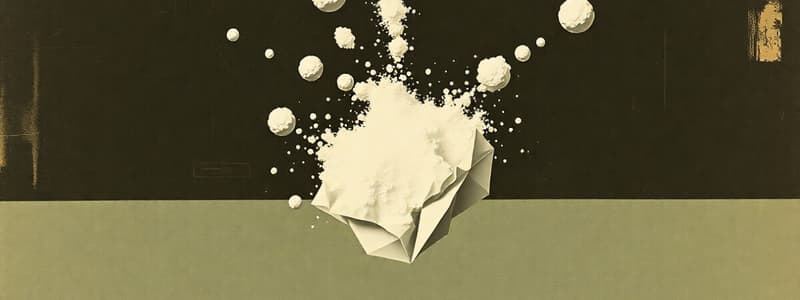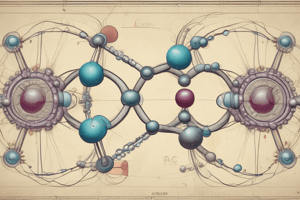Podcast
Questions and Answers
When sodium and chlorine react, what compound is formed?
When sodium and chlorine react, what compound is formed?
- Chlorosodium
- Sodium chloride (correct)
- Sodium chlorate
- Chlorine sodium
What happens to a sodium atom when it loses an electron to form an ion?
What happens to a sodium atom when it loses an electron to form an ion?
- It becomes a negative ion with a -1 charge.
- It becomes a neutral ion with no charge.
- It remains a neutral atom.
- It becomes a positive ion with a +1 charge. (correct)
Which statement best describes why noble gases are typically unreactive?
Which statement best describes why noble gases are typically unreactive?
- They have full outer electron shells. (correct)
- They have incomplete outer electron shells.
- They have very few electrons.
- They readily gain electrons.
What is the charge of a chloride ion ($Cl^-$) that has 17 protons and 18 electrons?
What is the charge of a chloride ion ($Cl^-$) that has 17 protons and 18 electrons?
Which of the following describes the process by which a chlorine atom achieves a full outer electron shell?
Which of the following describes the process by which a chlorine atom achieves a full outer electron shell?
What is the correct symbol for a sodium ion, indicating its charge?
What is the correct symbol for a sodium ion, indicating its charge?
When sodium is heated in a jar of chlorine, what visual evidence indicates a chemical reaction is occurring?
When sodium is heated in a jar of chlorine, what visual evidence indicates a chemical reaction is occurring?
What is an ion?
What is an ion?
Which of the following equations best describes the formation of lithium chloride?
Which of the following equations best describes the formation of lithium chloride?
Which noble gas is used in lighthouse lamps and emits a beautiful blue light?
Which noble gas is used in lighthouse lamps and emits a beautiful blue light?
Flashcards
What is a compound?
What is a compound?
A substance formed when atoms of two or more elements are chemically combined.
What are noble gases?
What are noble gases?
Atoms described as unreactive or stable due to their full outer electron shells.
What is an ion?
What is an ion?
An atom that has lost or gained electrons, resulting in a net electric charge.
How does sodium become an ion?
How does sodium become an ion?
Signup and view all the flashcards
How does chlorine become an ion?
How does chlorine become an ion?
Signup and view all the flashcards
Why does sodium ion have a +1 charge?
Why does sodium ion have a +1 charge?
Signup and view all the flashcards
Why does chloride ion have a -1 charge?
Why does chloride ion have a -1 charge?
Signup and view all the flashcards
What is Sodium Chloride?
What is Sodium Chloride?
Signup and view all the flashcards
Study Notes
- Most elements form compounds
Compound Formation
- Sodium, when heated and placed in chlorine, burns with a bright flame.
- The result of this reaction is a white solid, called sodium chloride, which needs to be scraped from the sides of the jar.
- Sodium chloride is a compound formed from the chemical combination of sodium and chlorine atoms.
- The reaction can be described as: sodium + chlorine → sodium chloride.
- The "+" signifies "reacts with" and the "→" signifies "means to form."
- Most elements engage in reactions to create compounds.
- Examples of such reactions include: lithium + chlorine → lithium chloride, and hydrogen + chlorine → hydrogen chloride.
Achieving a Full Outer Shell: Sodium Atoms
- A sodium atom possesses only one electron in its outer shell.
- By transferring this electron to another atom, the sodium atom can achieve a full outer shell, thus transforming into a sodium ion.
- A sodium atom (11 protons, 11 electrons) can lose 1 electron to become a sodium ion (11 protons, 10 electrons), achieving an electron configuration of [2,8]+.
- A sodium ion carries a charge of +1 due to having 11 protons and only 10 electrons.
- Sodium is represented by the symbol Na, while the sodium ion is represented as Na+. The "+" denotes a positive charge. Na+ is a positive ion.
Achieving a Full Outer Shell: Chlorine Atoms
- A chlorine atom has 7 electrons in its outer shell.
- It can achieve a full outer shell by gaining one electron from another atom, becoming a chloride ion.
- A chlorine atom (17 protons, 17 electrons) can gain 1 electron, transforming into a chloride ion (17 protons, 18 electrons) with an electron configuration of [2,8,8].
- A chloride ion possesses a charge of -1, making it a negative ion, and is represented by the symbol Cl-.
Ions
- An atom transforms into an ion when it either loses or gains electrons.
- An ion represents a charged particle that contains an unequal number of protons and electrons.
Noble Gases and Compound Formation
- Noble gases differ from other elements as they typically do not form compounds.
- Their atoms are described as unreactive or stable due to having full outer electron shells.
- A full outer shell contributes to an atom's stability.
- Only noble gas atoms have full outer shells.
- Atoms of all other elements have incomplete outer shells, which is why they react with each other.
- Through reactions with each other, atoms can achieve full outer shells.
- Helium, neon, and argon atoms have full outer shells and are stable.
- Certain noble gases, such as xenon, are used in lighting applications like lighthouse lamps, producing a beautiful blue light.
Studying That Suits You
Use AI to generate personalized quizzes and flashcards to suit your learning preferences.




